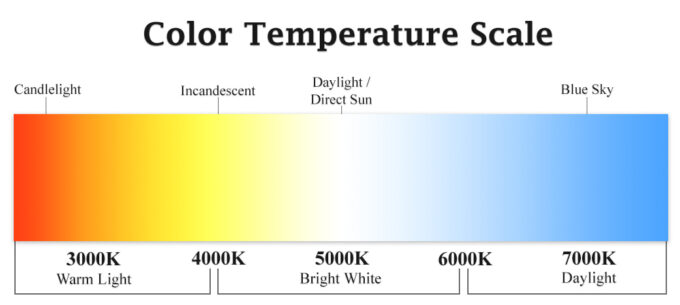Understanding Color Temperature in Interior Lighting
Color temperature plays a crucial role in creating comfortable and functional spaces. It refers to the warmth or coolness of light, measured in Kelvin (K). Lower color temperatures (below 3000K) produce warm, yellowish light, while higher temperatures (above 5000K) create cool, bluish light. Choosing the right color temperature is important for setting the mood, enhancing productivity, and ensuring comfort in various settings.
Color Temperature Recommendations for Different Occupant Settings
- Education:
Classrooms benefit from cool white light, usually between 4000K to 5000K. This range promotes alertness and concentration, helping students focus. Some schools use adjustable lighting to transition from warm to cool light, depending on the activity or time of day. - Retail:
Retail environments often use a mix of warm and cool lighting. Warm light (around 3000K) enhances product displays by creating a welcoming atmosphere, while cooler light (4500K to 5000K) is used in areas where clear, accurate visibility is needed. Flexibility in lighting helps highlight products and influence shopper behavior. - Office:
Offices typically use neutral to cool light, between 3500K and 5000K. Cooler light encourages productivity and reduces eye strain. Many modern offices incorporate tunable lighting systems that adjust brightness and color temperature throughout the day, mimicking natural light to boost employee well-being. - Medical:
In medical facilities, cool white light (5000K to 6500K) is preferred for areas like operating rooms and examination spaces. This range enhances visibility and ensures color accuracy, which is critical for medical procedures. For patient rooms, warmer lighting (2700K to 3000K) is recommended to create a calming environment. - Hospitality:
Hotels and restaurants benefit from warmer lighting, typically around 2700K to 3000K, as it creates a relaxing and inviting ambiance. Warmer light in lobbies, dining areas, and guest rooms fosters comfort and enhances the guest experience. - Residential:
For homes, lighting typically ranges from 2700K to 3500K. Warm white light in living rooms and bedrooms creates a cozy atmosphere, while neutral lighting in kitchens and bathrooms ensures clarity for tasks.
Trends in Lighting Technology for Flexibility
Advancements in lighting technology have made it easier to adjust color temperature based on function and time of day. Tunable LED lighting systems are growing in popularity across various sectors. These systems allow users to customize the color temperature with precision. For instance, in offices, lighting can shift from cooler tones in the morning to warmer tones in the evening, simulating natural daylight.
Additionally, smart lighting systems integrated with apps or building automation systems enable occupants to adjust lighting with ease. These systems are increasingly found in residential and hospitality settings, providing users with personalized control over lighting moods and intensities.
Moreover, Human-Centric Lighting (HCL) is a growing trend. HCL systems adjust light to support circadian rhythms, using color temperature to enhance well-being and productivity. This is particularly useful in settings like hospitals, offices, and schools.
Conclusion
Color temperature has a significant impact on the comfort and functionality of interior spaces. Each environment—whether educational, retail, office, medical, hospitality, or residential—has specific lighting needs. Emerging technologies like tunable LED systems and smart lighting offer flexibility, allowing spaces to adapt their lighting to various activities and moods.
Useful Resources:
- Lighting Research Center – Understanding Color Temperature
A detailed explanation of color temperature and its impact on interior environments. - Illuminating Engineering Society – Recommended Lighting Levels
This guide outlines recommended lighting levels for various settings, including color temperature guidance. - LEDinside – The Benefits of Tunable Lighting
This article discusses how tunable lighting is being used across industries to provide flexible lighting solutions.










